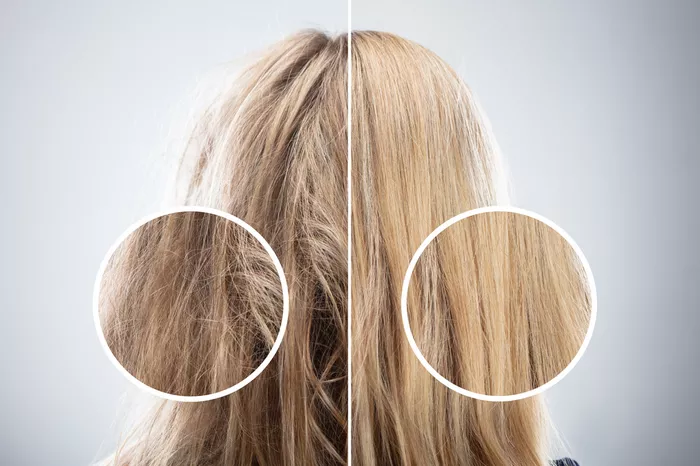Healthy, shiny hair is a symbol of beauty, but daily styling, environmental stressors, and chemical treatments can leave hair dry, brittle, and lifeless. While damaged hair cannot fully “heal” (since hair is not alive), its appearance and strength can be significantly improved. This guide breaks down the science of hair damage and offers actionable solutions to restore your hair’s health.
Understanding Hair Structure
To fix damaged hair, you must first understand its structure. Each strand has three layers:
- Cuticle: The outer layer made of overlapping scales (like roof shingles). It protects the inner layers.
- Cortex: The middle layer containing proteins (keratin) and pigments. It determines hair strength and elasticity.
- Medulla: The innermost layer (not always present), which adds volume.
Damage occurs when the cuticle lifts or breaks, exposing the cortex to breakage, moisture loss, and frizz.
Common Causes of Hair Damage
Heat Styling
Blow dryers, straighteners, and curling irons strip moisture and weaken keratin bonds.
Chemical Treatments
Bleaching, coloring, perms, and relaxers break down the cuticle, leading to porosity and brittleness.
Mechanical Damage
Brushing wet hair, tight hairstyles (ponytails, braids), and rough towels cause split ends and breakage.
Environmental Factors
Sunlight (UV rays), chlorine, saltwater, and pollution degrade proteins and dry out hair.
Poor Haircare Habits
Overwashing, harsh shampoos (sulfates), and skipping conditioner disrupt the hair’s natural balance.
Effective Ways to Repair Damaged Hair
Protein Treatments
- How They Work: Proteins like keratin fill gaps in the cuticle, temporarily reinforcing weak spots.
- Best For: Chemically treated or overprocessed hair.
- Products: Look for hydrolyzed wheat, soy, or silk proteins.
- DIY Option: Egg mask (mix 2 eggs + 1 tbsp olive oil; leave for 20 minutes).
- Tip: Use once every 2–4 weeks. Overuse can make hair stiff.
Deep Conditioning & Moisturizing
- Why It Matters: Dry hair lacks moisture, leading to breakage.
- Products: Creamy conditioners with shea butter, glycerin, or hyaluronic acid.
- DIY Option: Avocado + honey mask (mash 1 avocado + 2 tbsp honey; leave for 30 minutes).
- Tip: Apply heat (warm towel) to help conditioners penetrate.
Natural Oils
- Coconut Oil: Penetrates hair shaft, reducing protein loss. Apply to ends before washing.
- Argan Oil: Rich in antioxidants; seals split ends and adds shine.
- Jojoba Oil: Mimics scalp oil; ideal for dry scalps and frizz.
Leave-In Conditioners & Serums
These products coat hair, protecting it from friction and humidity. Use a heat-protectant serum before styling.
Minimize Heat Styling
- Let hair air-dry 50% before blow-drying.
- Use tools with temperature control (< 350°F).
- Try heatless styles (overnight braids, silk wraps).
Protect During Chemical Treatments
- Space out coloring sessions (8–12 weeks).
- Opt for ammonia-free dyes or balayage to reduce scalp contact.
- Use bond-building treatments (e.g., Olaplex No. 3) to repair disulfide bonds.
Diet & Supplements
- Protein: Eggs, fish, and nuts boost keratin production.
- Biotin & Vitamins A/C/E: Support scalp health and collagen.
- Omega-3s: Found in salmon and flaxseeds; reduce dryness.
Preventing Further Damage
- Wash Wisely: Use sulfate-free shampoos 2–3 times/week. Overwashing strips natural oils.
- Detangle Gently: Use a wide-tooth comb on wet hair, starting from the ends.
- Sleep on Silk: Silk pillowcases reduce friction and prevent breakage.
- UV Protection: Wear hats or use sprays with UV filters.
Professional Treatments
- Keratin Smoothing: Fills gaps in the cuticle, reducing frizz for up to 3 months.
- Olaplex: Repairs broken bonds from bleaching.
- Scalp Treatments: Exfoliate buildup and stimulate growth with salon-grade serums.
When to Trim
Split ends cannot be repaired—they must be cut. Trim every 8–12 weeks to prevent splits from traveling upward.
Myths vs. Facts
- Myth: “Products can permanently fix split ends.”
Fact: Trimming is the only solution. - Myth: “Natural remedies work overnight.”
Fact: Consistency is key; expect results in 4–8 weeks.
Conclusion
Repairing damaged hair requires patience and the right techniques. Focus on protein-moisture balance, gentle styling, and protective habits. While you can’t reverse all damage, these steps will restore shine, softness, and resilience. Consult a stylist for personalized advice, and remember: healthy hair starts with consistent care.
Related topics:
Can Dry And Damaged Hair Be Repaired
Can Protein Treatments Repair Damaged Hair
Can You Repair Bleach Damaged Hair


